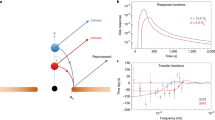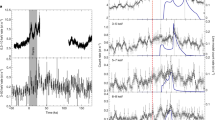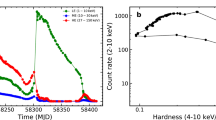Abstract
The geometry of the accretion flow around stellar-mass black holes can change on timescales of days to months1,2,3. When a black hole emerges from quiescence (that is, it ‘turns on’ after accreting material from its companion) it has a very hard (high-energy) X-ray spectrum produced by a hot corona4,5 positioned above its accretion disk, and then transitions to a soft (lower-energy) spectrum dominated by emission from the geometrically thin accretion disk, which extends to the innermost stable circular orbit6,7. Much debate persists over how this transition occurs and whether it is driven largely by a reduction in the truncation radius of the disk8,9 or by a reduction in the spatial extent of the corona10,11. Observations of X-ray reverberation lags in supermassive black-hole systems12,13 suggest that the corona is compact and that the disk extends nearly to the central black hole14,15. Observations of stellar-mass black holes, however, reveal equivalent (mass-scaled) reverberation lags that are much larger16, leading to the suggestion that the accretion disk in the hard-X-ray state of stellar-mass black holes is truncated at a few hundreds of gravitational radii from the black hole17,18. Here we report X-ray observations of the black-hole transient MAXI J1820+07019,20. We find that the reverberation time lags between the continuum-emitting corona and the irradiated accretion disk are 6 to 20 times shorter than previously seen. The timescale of the reverberation lags shortens by an order of magnitude over a period of weeks, whereas the shape of the broadened iron K emission line remains remarkably constant. This suggests a reduction in the spatial extent of the corona, rather than a change in the inner edge of the accretion disk.
This is a preview of subscription content, access via your institution
Access options
Access Nature and 54 other Nature Portfolio journals
Get Nature+, our best-value online-access subscription
$29.99 / 30 days
cancel any time
Subscribe to this journal
Receive 51 print issues and online access
$199.00 per year
only $3.90 per issue
Buy this article
- Purchase on Springer Link
- Instant access to full article PDF
Prices may be subject to local taxes which are calculated during checkout




Similar content being viewed by others
Data availability
The datasets analysed during this study are available at NASA’s High Energy Astrophysics Science Archive Research Center (HEASARC; https://heasarc.gsfc.nasa.gov/).
References
Remillard, R. A. & McClintock, J. E. X-ray properties of black-hole binaries. Annu. Rev. Astron. Astrophys. 44, 49–92 (2006).
Fender, R. P., Belloni, T. M. & Gallo, E. Towards a unified model for black hole X-ray binary jets. Mon. Not. R. Astron. Soc. 355, 1105–1118 (2004).
Done, C., Gierliński, M. & Kubota, A. Modelling the behaviour of accretion flows in X-ray binaries. Everything you always wanted to know about accretion but were afraid to ask. Astron. Astrophys. Rev. 15, 1–66 (2007).
Rees, M. J., Begelman, M. C., Blandford, R. D. & Phinney, E. S. Ion-supported tori and the origin of radio jets. Nature 295, 17–21 (1982).
Narayan, R., McClintock, J. E. & Yi, I. A new model for black hole soft X-ray transients in quiescence. Astrophys. J. 457, 821 (1996).
Shakura, N. I. & Sunyaev, R. A. Black holes in binary systems. Observational appearance. Astron. Astrophys. 24, 337–355 (1973).
Steiner, J. F. et al. The constant inner-disk radius of LMC X-3: a basis for measuring black hole spin. Astrophys. J. 718, L117–L121 (2010).
Plant, D. S., Fender, R. P., Ponti, G., Muñoz-Darias, T. & Coriat, M. Revealing accretion on to black holes: X-ray reflection throughout three outbursts of GX 339–4. Mon. Not. R. Astron. Soc. 442, 1767–1785 (2014).
Ingram, A. & Done, C. A physical model for the continuum variability and quasi-periodic oscillation in accreting black holes. Mon. Not. R. Astron. Soc. 415, 2323–2335 (2011).
Fabian, A. C. et al. On the determination of the spin and disc truncation of accreting black holes using X-ray reflection. Mon. Not. R. Astron. Soc. 439, 2307–2313 (2014).
García, J. A. et al. X-ray reflection spectroscopy of the black hole GX 339–4: exploring the hard state with unprecedented sensitivity. Astrophys. J. 813, 84 (2015).
Fabian, A. C. et al. Broad line emission from iron K- and L-shell transitions in the active galaxy 1H0707-495. Nature 459, 540–542 (2009).
Uttley, P., Cackett, E. M., Fabian, A. C., Kara, E. & Wilkins, D. R. X-ray reverberation around accreting black holes. Astron. Astrophys. Rev. 22, 72 (2014).
Zoghbi, A., Fabian, A. C., Reynolds, C. S. & Cackett, E. M. Relativistic iron K X-ray reverberation in NGC 4151. Mon. Not. R. Astron. Soc. 422, 129–134 (2012).
Kara, E. et al. A global look at X-ray time lags in Seyfert galaxies. Mon. Not. R. Astron. Soc. 462, 511–531 (2016).
Uttley, P. et al. The causal connection between disc and power-law variability in hard state black hole X-ray binaries. Mon. Not. R. Astron. Soc. 414, L60–L64 (2011).
De Marco, B., Ponti, G., Muñoz-Darias, T. & Nandra, K. Tracing the reverberation lag in the hard state of black hole X-ray binaries. Astrophys. J. 814, 50 (2015).
De Marco, B. et al. Evolution of the reverberation lag in GX 339–4 at the end of an outburst. Mon. Not. R. Astron. Soc. 471, 1475–1487 (2017).
Kawamuro, T. et al. MAXI/GSC detection of a probable new X-ray transient MAXI J1820+070. Astron. Telegr. 11399 (2018).
Uttley, P. et al. NICER observations of MAXI J1820+070 suggest a rapidly-brightening black hole X-ray binary in the hard state. Astron. Telegr. 11423 (2018).
Tucker, M. A. et al. ASASSN-18ey: the rise of a new black-hole X-ray binary. Astrophys. J. 867, L9 (2018).
Gendreau, K. C. et al. The Neutron star Interior Composition Explorer (NICER): design and development. Proc. SPIE 9905, 99051H (2016).
Díaz Trigo, M., Sidoli, L., Boirin, L. & Parmar, A. N. XMM-Newton observations of GX 13 + 1: correlation between photoionised absorption and broad line emission. Astron. Astrophys. 543, A50 (2012).
Homan, J. et al. NICER observations of MAXI J1820+070: continuing evolution of X-ray variability properties. Astron. Telegr. 11576 (2018).
Gandhi, P., Rao, A., Johnson, M. A. C., Paice, J. A. & Maccarone, T. J. Gaia DR2 distances and peculiar velocities for Galactic black hole transients. Preprint at https://arxiv.org/abs/1804.11349 (2018).
Miyamoto, S. & Kitamoto, S. X-ray time variations from Cygnus X-1 and implications for the accretion process. Nature 342, 773 (1989).
Altamirano, D. & Méndez, M. The evolution of the X-ray phase lags during the outbursts of the black hole candidate GX 339–4. Mon. Not. R. Astron. Soc. 449, 4027–4037 (2015).
Papadakis, I. E., Nandra, K. & Kazanas, D. Frequency-dependent time lags in the X-ray emission of the Seyfert galaxy NGC 7469. Astrophys. J. 554, L133–L137 (2001).
Kotov, O., Churazov, E. & Gilfanov, M. On the X-ray time-lags in the black hole candidates. Mon. Not. R. Astron. Soc. 327, 799–807 (2001).
Parker, M. L. et al. NuSTAR and Suzaku observations of the hard state in Cygnus X-1: locating the inner accretion disk. Astrophys. J. 808, 9 (2015).
Ludlam, R. M. et al. Detection of reflection features in the neutron star low-mass X-ray binary Serpens X-1 with NICER. Astrophys. J. 858, L5 (2018).
Mastroserio, G., Ingram, A. & van der Klis, M. Multi-time-scale X-ray reverberation mapping of accreting black holes. Mon. Not. R. Astron. Soc. 475, 4027–4042 (2018).
Mahmoud, R. D., Done, C. & De Marco, B. Reverberation reveals the truncated disc in the hard state of GX 339-4. Preprint at https://arxiv.org/abs/1811.06911 (2018).
Fausnaugh, M. M. et al. Space telescope and optical reverberation mapping project. III. Optical continuum emission and broadband time delays in NGC 5548. Astrophys. J. 821, 56 (2016).
Edelson, R. et al. Swift monitoring of NGC 4151: evidence for a second X-ray/UV reprocessing. Astrophys. J. 840, 41 (2017).
Gandhi, P. et al. Furiously fast and red: sub-second optical flaring in V404 Cyg during the 2015 outburst peak. Mon. Not. R. Astron. Soc. 459, 554–572 (2016).
Vincentelli, F. M. et al. Characterization of the infrared/X-ray subsecond variability for the black hole transient GX 339-4. Mon. Not. R. Astron. Soc. 477, 4524–4533 (2018).
Acknowledgements
E.K. thanks G. Ryan and P. Teuben for discussions on ways to speed up the Python code and J. Garcia and D. Buisson for discussions on NuSTAR observations of MAXI J1820+070. E.K. acknowledges support from the Hubble Fellowship Program and the University of Maryland Joint Space Science Institute and the Neil Gehrels Endowment in Astrophysics through the Neil Gehrels Prize Postdoctoral Fellowship. Support for program number HST-HF2-51360.001-A was provided by NASA through a Hubble Fellowship grant from the Space Telescope Science Institute, which is operated by the Association of Universities for Research in Astronomy, Inc., under NASA contract NAS5-26555. J.F.S. was supported by NASA Einstein Fellowship grant PF5-160144. E.M.C. acknowledges NSF CAREER award AST-1351222. D.A. acknowledges support from the Royal Society. This work was supported by NASA through the NICER mission and the Astrophysics Explorers Program, and made use of data and software provided by the High Energy Astrophysics Science Archive Research Center (HEASARC).
Reviewer information
Nature thanks D. Haggard and the other anonymous reviewer for their contribution to the peer review of this work.
Author information
Authors and Affiliations
Contributions
E.K. led timing analysis and interpretation of results. J.F.S. produced the HID and contributed to interpretation of results. A.C.F. performed spectral modelling and contributed to interpretation of results. E.M.C. and P.U. performed cross-checks of analysis software and contributed to interpretation of results. R.A.R. contributed to background modelling and interpretation of results. K.C.G. and Z.A. scheduled the NICER observations and contributed to data reduction. D.A., J.H., S.E., T.E., J.N. and A.L.S. contributed to interpretation of results.
Corresponding author
Ethics declarations
Competing interests
The authors declare no competing interests.
Additional information
Publisher’s note: Springer Nature remains neutral with regard to jurisdictional claims in published maps and institutional affiliations.
Extended data figures and tables
Extended Data Fig. 1 The power spectral evolution.
The 0.3–10-keV Poisson noise-subtracted power spectra (in units of (root-mean-square/mean)2 with 1σ errors) for the six epochs of interest (same colour scheme throughout). The solid lines on the top-right portion of the figure indicate the frequencies used in the lag–energy analysis (Fig. 3).
Extended Data Fig. 2 The low-frequency lag–energy spectra.
The low-frequency (0.1–1-Hz) lag–energy spectra for the six epochs. The lags have been shifted such that the lowest-energy lag starts at zero. No thermal lag is seen at low frequencies. Error bars indicate 1σ confidence intervals.
Extended Data Fig. 3 Modelling the lag–energy spectra.
a, Case A; b, case B. The top panels show the best-fitting models fitted to epoch 1 (ObsID 1200120106), demonstrating how the significance and amplitude of the Fe K lag are determined. The middle panels show the ratio of the data to the null hypothesis (POWERLAW+DISKBB). The case A null hypothesis is assuming a continuum lag power-law index of zero, whereas case B allows for a non-zero continuum lag. The bottom panels show the ratio of the data to the best-fitting model (POWERLAW+DISKBB+LAOR+LAOR), again where case B allows for a non-zero power-law continuum lag. See text and Extended Data Table 2 for details on the best-fit parameters and χ2 fit statistics. Error bars indicate 1σ confidence intervals.
Extended Data Figure 4 Lags from other observations.
a, The frequency range of the high-frequency soft lags (lags between 0.5–1 keV and between 1–10 keV) for all observations between epoch 1 and 6. The general trend is that the soft lags increase to higher frequencies over time. The coloured dots show the frequency ranges for the six epochs studied. b, The hardness–intensity diagram, defined as the total 0.2–12-keV count rate versus the ratio of hard (4–12 keV) to soft (2–4 keV) count rates (as in Fig. 1c) for all available data up to MJD 58,344. This extended hardness–intensity diagram shows the recent transition to the soft state. In the right two panels, we show the lags from the earliest observations from the beginning of the outburst (dark-red hashed region) and from the latest times where we can measure high-frequency time lags, at the beginning of the transition to the soft state (purple hashed region). c, Comparison of the lag–frequency spectrum of the first epoch (ObsID 06) and the five co-added ObsIDs that preceded it (MJD 58,189 to MJD 58,193). The inset shows a comparison of the ratio of the energy spectra in these epochs to a power-law fit in the range 3–10 keV. d, The corresponding lag–energy spectra for the 3–30-Hz range, where Fe K lags were seen in epoch 1. The earlier observations (ObsIDs 01–05) show a dominating hard lag at high energies, and no evidence for Fe K lags. e, f, As in c and d, but comparing the lag–frequency spectra and lag–energy spectra of epoch 6 to later observations as the source begins to transition to the soft state. Error bars indicate 1σ confidence intervals.
Rights and permissions
About this article
Cite this article
Kara, E., Steiner, J.F., Fabian, A.C. et al. The corona contracts in a black-hole transient. Nature 565, 198–201 (2019). https://doi.org/10.1038/s41586-018-0803-x
Received:
Accepted:
Published:
Issue Date:
DOI: https://doi.org/10.1038/s41586-018-0803-x
Comments
By submitting a comment you agree to abide by our Terms and Community Guidelines. If you find something abusive or that does not comply with our terms or guidelines please flag it as inappropriate.



